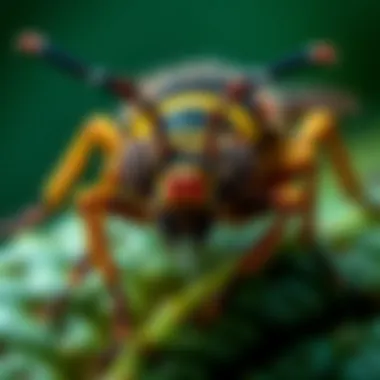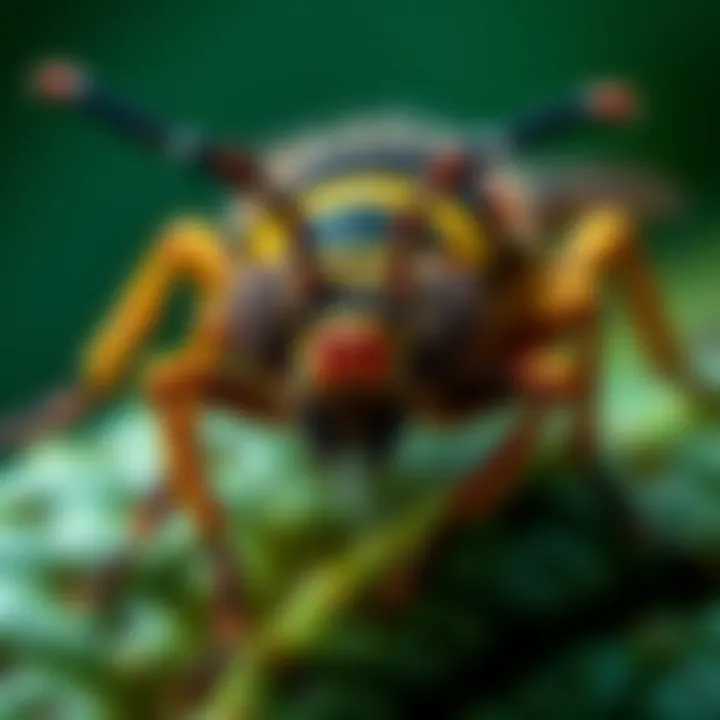Exploring Advanced Techniques in Pest Control


Intro
In recent years, pest management has evolved beyond the classical methods that many of us grew up knowing. Gone are the days of simply spraying chemicals and hoping for the best. Today, homeowners are looking for solutions that fuse innovation with sustainability. This holistic approach not only targets pests but also emphasizes the importance of understanding pest behavior and the ecosystem.
This article offers an in-depth look at the multifaceted dimensions of modern pest control. Each section will peel back the layers of this topic, presenting insights that homeowners and gardening enthusiasts alike can incorporate into their daily practices.
Understanding the Pest
To tackle pest issues effectively, one must first understand the pests themselves. Knowledge is power. Let's dive into two critical aspects: identification and life cycle.
Identification
Identifying various pests is the cornerstone of effective pest control. Pests come in all shapes and sizes—from the tiniest ant to the much-dreaded termite. Some common household pests include:
- Ants
- Cockroaches
- Rodents
- Bedbugs
- Termites
Each pest has its unique characteristics and behavioral patterns. For instance, ants often leave pheromone trails leading to food sources, while cockroaches are nocturnal and tend to hide in dark crevices. By recognizing these traits, homeowners can take timely and appropriate action.
Life Cycle
Understanding the life cycle of pests is crucial for developing long-term control strategies. Most pests go through several stages, such as:
- Egg
- Larva/Nymph
- Pupa/Instar
- Adult
Recognizing these stages allows for targeted interventions. For example, treatments may be more effective during the larval stage when pests are vulnerable. Understanding the timelines associated with each life cycle can also help dictate when to initiate control methods. Also, it's worth noting that some pests reproduce quickly, making it essential to act before their populations explode.
Pest Prevention Strategies
Once you've identified the pests at your door, the next step is prevention. By modifying the environment and providing physical barriers, homeowners can deter pests before they invite themselves in.
Environment Modification
Altering the surroundings can diminish the likelihood of a pest invasion. A few effective strategies include:
- Sealing cracks and gaps: Many pests can enter through tiny openings; sealing these can go a long way.
- Proper waste disposal: Keeping trash contained and cleaning up food spills can reduce food sources for pests.
- Strategic landscaping: Trim back shrubs and trees, as they can offer pathways for pests to access your home.
Physical Barriers
In addition to environmental modifications, you can employ barriers to create more defenses against pests:
- Insect mesh screens: Installing screens on windows and doors can prevent insects from entering.
- Trap systems: Variety of traps are available that can capture rodents and insects without using toxic chemicals.
- Moats: In some cases, a moat of water can keep crawling pests away from plants or structures.
"An ounce of prevention is worth a pound of cure."
This idiom rings true in the realm of pest control, emphasizing proactive measures over reactive ones.
Control Methods
Despite best efforts, some pests may still infiltrate. Understanding the available control methods can help you respond effectively. There are mainly two paths one can take: chemical control and biological control.
Chemical Control
While chemical solutions often come under scrutiny, not all products are harmful. New formulations focus on being eco-friendly while still delivering results. Homeowners should look for sprays and dust that target specific pests instead of broad-spectrum chemicals that can affect beneficial insects as well.
Biological Control
Biological control employs natural predators to keep pest populations in check. For example, ladybugs can help control aphid populations in gardens. Nematodes are microscopic worms that can target soil pests. This method taps into the complexity of ecosystems, promoting a balance rather than a simple eradication.
Pest control is no longer just about squashing bugs but engaging with nature proactively. As the realms of technology and sustainable practices continue to converge, the options available for pest management become more integrated and effective. Homeowners equipped with knowledge and innovative solutions can navigate their pest challenges successfully. This article aims to empower you with the tools necessary to embrace a responsible and comprehensive approach to pest management.
Intro to Pest Control
Effective pest management is not just about keeping pesky critters at bay; it's a vital element of maintaining a healthy environment in our homes and gardens. These pests can wreak havoc on crops, spread diseases, and cause structural damage to properties. Therefore, understanding pest control is of utmost importance for homeowners. By adopting effective methods, individuals not only safeguard their property but also contribute to environmental sustainability.
The complexity of pest behavior and the impact of various control methods present both challenges and opportunities. Homeowners must grasp the various techniques available today, including non-toxic solutions that protect the ecosystem.
Moreover, pest control is a shared responsibility. Neighbors need to work hand in hand to effectively manage pest populations. One household's inattention can lead to widespread outbreaks in the community. Fostering a collaborative approach can enhance the efficacy of pest management practices across neighborhoods.
The Importance of Effective Pest Management
Effective pest management is essential for a multitude of reasons. Firstly, it directly ties into health safety. Pests can transmit diseases; from cockroaches to rodents, the risks they pose are significant. Households must actively manage these visitors to diminish the chances of illness. Imagine a child falling sick simply because a few stray ants decided your kitchen was the perfect dining establishment. That's a reality many homeowners face.
Secondly, maintaining structural integrity is crucial. The likes of termites and carpenter ants can slowly eat away at the wooden framework of a home, leading to costly repairs in the long run. Ignoring pest presence might seem trivial at first, but those minor issues can snowball into major problems.


Thirdly, the financial impact should not be overlooked. Investing in effective pest control can save significant dollars over time. With a proactive approach, homeowners can avoid the high costs associated with extensive pest damage or major infestations.
Lastly, embracing effective pest management contributes to a healthier planet. Choosing eco-friendly pest control options ensures that we do not harm beneficial insects, birds, or local wildlife in the process.
Historical Context of Pest Control Practices
Delving into the history of pest control reveals a fascinating evolution of techniques and beliefs. Ancient civilizations had their own methods for dealing with pests. For instance, the Egyptians used cats to control rodent populations, capitalizing on the cat’s natural hunting instincts. In contrast, the Greeks employed sulfur to ward off insects and pests, a rudimentary form of developing chemical methods.
As agriculture grew and the need for crops increased, so too did the tactics for pest management. The Industrial Revolution brought about synthetic pesticides, fundamentally changing the game. However, these advancements came with their own set of challenges, notably environmental and health concerns.
The latter half of the 20th century saw a shift towards more sustainable practices, as scientists and agricultural specialists began to recognize the long-term implications of chemical dependency. This period prompted a change in mindset, placing greater emphasis on Integrated Pest Management (IPM) strategies. Through IPM, pest control became more about understanding and harmonizing with natural systems rather than outright extermination. Today, this historical context lays the groundwork for further advancements in pest control, pushing for innovative techniques that marry technology with an understanding of ecosystems.
For further reading on the historical context of pest control practices, you might find resources at Wikipedia and Britannica.
Understanding Pest Behavior
Understanding the behavior of pests is vital for effective pest control. Recognizing how pests interact with their environment, what they eat, and their life cycles can lead to more effective management strategies. By delving into the intricacies of pest behavior, homeowners can better anticipate pest activity and implement proactive measures to prevent infestations.
Pest behavior is shaped by instincts and environmental factors, significantly influencing their life cycles and interactions with humans. A deeper understanding offers numerous benefits:
- Identification of Vulnerabilities: Knowing when and where pests are most active allows homeowners to target their efforts more effectively.
- Enhanced Control Strategies: Effective strategies can be developed by aligning control methods with pest habits.
- Resource Optimization: By pinpointing when to act, both time and budget can be optimized into fewer, more effective pest management efforts.
The Life Cycle of Common Pests
The life cycle of pests can vary significantly depending on the species, but typically involves stages such as egg, larva, pupa, and adult. For instance, the life cycle of the common housefly includes:
- Egg: Laid in decaying matter; these eggs hatch into larvae.
- Larvae: Often referred to as maggots, these pests feed and grow for several days.
- Pupae: After a feeding phase, they enter a pupal stage where they metamorphose.
- Adult: Emerging as adult flies, they are then capable of laying eggs themselves.
Understanding the specific life cycles of pests can aid in planning when interventions are most effective. Homeowners aware of these cycles can significantly reduce the chances of a recurring infestation.
Feeding and Nesting Habits
Different pests not only choose various food sources but also have specific nesting preferences. Ants, for example, are known to form colonies, while cockroaches prefer dark, damp places for nesting. The feeding preferences of pests dictate where they are likely to be found:
- Ants: Often attracted to sugary substances, they might invade kitchens or pantries.
- Bed Bugs: Nest in bed frames and couches, feeding primarily on human blood at night.
- Termites: More than just a wood nuisance, they can compromise a home's structural integrity by feeding on cellulose.
Identifying these habits will provide homeowners with clues about where to look for infestations and how best to tackle them.
Seasonal Patterns of Pest Activity
Pests are not static; their populations and behaviors often fluctuate with the seasons. Understanding these patterns can be crucial:
- Spring: A time for emergence; many pests awaken or hatch.
- Summer: Population booms often occur in warmer months.
- Fall: Pests begin seeking shelter, leading them closer to human dwellings.
- Winter: Many pests hibernate or find warmth in homes, increasing noticeable activity indoors.
By recognizing these seasonal shifts, homeowners can adapt their pest control plans in advance. This foresight enables better preparedness, thereby limiting pest-related challenges.
"Understanding pest behavior underscores the foundation of effective pest management—knowledge is not only powerful, it’s preventive."
For comprehensive insights on pest control and management, you can refer to reputable sources such as Wikipedia on Pest Control or check out this article from Britannica.
Innovative Pest Control Technologies
In the evolving realm of pest management, the integration of innovative technologies is pivotal. These advancements not only enhance efficacy but also sustainability, an increasingly vital concern in today’s ecological landscape. Stakeholders from homeowners to pest control professionals stand to gain from understanding these innovations. Let's examine several advanced techniques reshaping pest management practices today.
Biological Control Methods
Use of Natural Predators
The use of natural predators is a fascinating strategy that revolves around leveraging one species to control the population of another. For instance, introducing ladybugs can significantly reduce aphid populations in gardens. The core appeal here lies in its eco-friendly nature—no chemicals or toxic substances involved.
A key characteristic of this method is that it establishes a more balanced ecosystem. By working with nature, rather than against it, we encourage biodiversity. This choice is particularly beneficial as it addresses pests without harming the environment or beneficial insects. The unique feature of employing natural predators is the resilience it builds within the ecosystem, making it less susceptible to future infestations. The downside, however, is that it may take time for these natural methods to show significant results compared to more aggressive chemical controls.
Impact on Ecosystems
When we consider the impact on ecosystems, the choice of pest control methods becomes critical. Biological methods like these contribute positively by promoting healthy ecosystems. They help maintain natural food webs and contribute to soil health. A key aspect here is the reduced chemical runoff, which in turn protects water bodies from pollution.
Notably, these methods offer long-term sustainability, as they create an environment less reliant on human intervention. However, drawbacks can include variability in effectiveness based on environmental conditions. Thus, while they bring about numerous benefits, one must also assess the situational suitability of employing such techniques in various ecosystems.
Technological Advancements in Pest Monitoring
Smart Traps
Smart traps are gaining momentum in pest control due to their advanced technology integration. These traps utilize sensors and online connectivity to monitor pest presence, sending alerts directly to users’ smartphones. The main benefit lies in their ability to provide real-time data, drastically altering the way pest control issues are approached at home.


Such traps can distinguish between species, giving a clearer picture of the problem at hand. This specificity allows for targeted action, reducing unnecessary interventions. On the flip side, the dependency on technology can lead to complications. If the power goes out or connectivity is lost, monitoring becomes challenging. However, when operational, they greatly enhance pest control efficiency.
Data Analytics in Pest Control
The application of data analytics in pest control is another groundbreaking trend. By analyzing data on pest populations, treatment successes, and environmental conditions, pest control initiatives can be significantly optimized. This approach allows for informed decision-making, enhancing timing and methods of intervention.
One key strength is the potential to identify patterns over time, enabling preemptive action rather than reactive measures. Yet, this strategy necessitates robust data collection mechanisms, which might not be available in all situations. Still, as more tech-savvy solutions evolve, the promise of data-driven strategies is exciting.
Application of Drones in Pest Management
Drones are not just gadgets for hobbyists; they’re proving to be noteworthy in pest management as well. These aerial devices can survey extensive tracts of land, diagnosing infestations from above without the need for potentially dangerous proximity to pesticides. Equipped with cameras and sensors, drones enable swift identification of problem areas, which might be missed during conventional inspections.
Utilizing drones offers distinct advantages such as higher coverage area and a less invasive approach compared to traditional inspection methods. However, the costs associated with drone technology can be a hurdle for smaller operations. Despite these challenges, the efficiency and accuracy drones bring make them a promising tool in the future of pest management.
Sustainable and Eco-Friendly Practices
In the world of pest management, sustainable and eco-friendly practices are not just a trend; they are becoming a necessity. With increasing environmental concerns and the awareness of chemical effects on health, adopting these practices benefits homeowners and contributes positively to the ecosystem. Sustainable pest control emphasizes minimal impact on the environment while achieving effective pest management. This approach entails a blend of techniques that focus not only on eradicating pests but also on promoting a balanced ecosystem.
Integrated Pest Management Strategies
Combination Techniques
Combination techniques are a cornerstone of integrated pest management (IPM). They leverage various methods—biological, cultural, mechanical, and chemical—to address pest problems. This strategy focuses on understanding the ecological aspects of pest control, which makes it a powerful ally for homeowners. A key characteristic of combination techniques is their flexibility; using multiple approaches allows homeowners to tailor their pest management plans according to specific pest problems and their environments.
For instance, incorporating natural predators alongside targeted pesticide applications can reduce the need for chemicals while still managing pest populations. One unique feature of combination techniques is that they often lead to sustainable outcomes: once a balance is established, the reliance on invasive chemicals can be greatly diminished. However, homeowners must remain vigilant, as this approach requires constant monitoring to ensure effectiveness. In essence, combination techniques represent a robust and adaptive method that balances effectiveness and environmental responsibility.
Monitoring and Evaluation
Monitoring and evaluation are critical components that drive the success of pest control strategies. These practices involve continuous observation and assessment of pest populations, environmental conditions, and the effectiveness of control measures. The key characteristic here is data-driven decision-making—homeowners can make informed choices based on actual conditions rather than assumptions.
Effective monitoring not only highlights emerging pest issues before they become severe but also helps in adapting strategies to changing circumstances. For example, using sticky traps or digital pest monitoring systems can provide real-time data on pest activity. A unique feature of this approach is the ability to shift from reactive measures to proactive prevention. However, this process can be resource-intensive, requiring time and dedication from homeowners. Nevertheless, the benefits gained from thorough monitoring—reducing pesticide use and ensuring a healthier environment—make this an important practice in sustainable pest management.
Utilizing Beneficial Insects
The role of beneficial insects in pest management cannot be overstated. These tiny allies, such as ladybugs and lacewings, serve as natural predators to many common pests, providing a low-impact solution to pest control. Promoting a habitat that nurtures beneficial insects can help keep pest populations in check without the need for harsh chemicals. Integrating such insects into garden ecosystems is an eco-friendly method embraced by many homeowners who seek alternatives to conventional pesticides.
Creating environments conducive to beneficial insects often involves planting native flora that provides food and shelter. This not only supports the family of beneficial bugs but also promotes biodiversity. Homeowners can gain comfort and assurance knowing that while they address pest issues, they also support the health of their gardens and local ecosystems.
Organic Pest Control Solutions
Organic pest control solutions are an effective alternative for homeowners who are cautious about the implications of synthetic chemicals on their health and the environment. This approach utilizes naturally derived substances to combat pests, leading to methods that are safer for both people and pets. Organic solutions like neem oil or diatomaceous earth show that pest control doesn’t have to be synonymous with harmful chemicals.
One of the significant benefits of organic solutions is that they often pose minimal risk to beneficial insects and overall ecological balance. Additionally, these methods tend to degrade naturally, leaving fewer toxic residues in gardens. However, it’s essential that homeowners understand that organic doesn’t always equal effortless. They typically require more frequent applications and targeted timing to ensure effectiveness. Despite the challenges, the adoption of organic pest control fosters a healthier home environment and is a commendable strategy for those prioritizing sustainability.
The future of pest management lies in sustainable practices, as they not only address immediate pest problems but also pave the way for healthier ecosystems.
Challenges in Pest Control Management
Pest control is not merely about getting rid of unwanted guests in your home or garden; it’s about safeguarding the health and safety of your surroundings. However, modern methods face several hurdles. Understanding these challenges helps in crafting more effective pest management strategies. Among these, the most pressing issues involve chemical resistance and environmental impacts. Addressing these challenges is paramount for sustainable practices.
Resistance to Chemical Control
Chemical pest control methods have been a staple in the industry for decades. Yet, in recent years, a troubling phenomenon has emerged – pests developing resistance to these chemicals. This means that previously effective treatments become less potent, forcing home owners to use higher doses or alternative products, creating a cycle that can be both costly and hazardous.
Common household pests like ants, cockroaches, and bed bugs have shown alarming adaptability to chemical pesticides. Factors contributing to this resistance include over-reliance on a limited spectrum of chemicals, improper application techniques, and a lack of awareness about integrated pest management strategies. Homeowners often see no immediate results, which prompts them to exacerbate the situation by applying more products, leading to a significant increase in pesticide exposure.
It’s crucial to use a diversified approach. By utilizing biological controls or even mechanical methods alongside chemical treatments, householders can significantly decrease the likelihood of resistance developing in pest populations.
"Adapting our strategies not just prolongs the effectiveness of our tools, but also serves as a crucial step towards sustainability."
Environmental Impact Concerns
The environmental repercussions of pest control practices are increasingly coming under scrutiny. The use of certain pesticides can have detrimental effects not only on target pests but also on beneficial insects, such as bees and butterflies. Additionally, chemical runoff can contaminate groundwater and affect local ecosystems. This poses a serious health risk not just for pests but also for humans and pets residing in the affected areas.
In recent years, there has been growing awareness and a call for more eco-friendly alternatives. Homeowners can adopt practices such as planting native species that repel pests or encouraging natural predators that can help keep pest populations in check without harming the environment. Adopting these methods can promote a balanced ecosystem, fostering a healthier environment for everyone.
To navigate these challenges effectively:
- Educate Yourself: Understand the types of pests that are common in your area and their behaviors.
- Choose Products Wisely: Opt for environmentally safe products; check labels, and consult experts if needed.
- Monitor Pest Activity: Implement regular checks to keep pest levels manageable before they escalate.
- Engage in Community Programs: Participate in initiatives aimed at educating others about sustainable pest control techniques.
The journey towards innovative pest control involves both acknowledging these challenges and actively seeking solutions that care for both our homes and the planet.
Case Studies in Advanced Pest Control


Understanding real-world applications of advanced pest control techniques helps illustrate their effectiveness and the potential for widespread implementation. Case studies not only provide tangible examples of success but also highlight challenges faced during the adoption of innovative practices. This section emphasizes the significance of documented experiences, focusing on successful implementations of new technologies and community-wide initiatives that show how modern strategies can combat pest-related issues.
Successful Implementations of New Technologies
In recent years, several organizations and municipalities have embarked on integrating modern technologies into pest control strategies. One standout example is the collaboration between major cities and tech firms to develop smart pest-monitoring systems.
For instance, San Francisco has taken strides towards bioremediation by employing sensors that track pest movement and density in real time. This data enables proactive measures before infestations escalate. The municipality reports a 25% reduction in pest-related complaints since the start of their initiative.
Relevant technologies include:
- Remote Sensors: Monitoring where pests congregate most frequently.
- AI-Powered Analytics: Providing insights into pest behavior patterns, allowing for more targeted control measures.
- Automated Traps: These use minimal chemicals, aligning with public preference for eco-friendly solutions.
"Effective pest management relies not just on tools but also on understanding the unique biology and behavior of local pest populations."
These technologies underscore the practicality of merging data science with pest management, convincing not only policymakers but also homeowners of the potential benefits.
Community-Wide Initiatives
Community initiatives often emerge as grassroots solutions to common pest problems, utilizing a more holistic approach. In Wisconsin, a community-level initiative tackled a prevalent issue with mice invasions through education and collaboration among residents.
This program centered around:
- Workshops and Training Sessions: Teaching households inclusive pest prevention practices that prioritize hygiene and awareness.
- Resource Sharing: Local communities distributed safe traps and eco-friendly repellents, helping families implement pest control without resorting to hazardous solutions.
- Community Watch: Neighbors formed monitoring groups to report sightings and share strategies for effective pest management.
The outcomes have been promising; communities involved reported a significant decrease in rodent encounters while fostering a sense of collective responsibility. Not only does this enhance pest management methods, it also cultivates camaraderie among residents.
In summary, case studies illustrate the landscape of innovative pest control solutions, showcasing real evidence of their success and reinforcing the viability of advanced techniques. Such examples offer a beacon of hope for tackling pest issues effectively while considering environmental impacts.
Future Directions in Pest Control
Future directions in pest control hold significant importance as we look to innovate and adapt our strategies. These strategies aim not just to eradicate pests, but to do so in a manner that is effective, sustainable, and responsive to the evolving dynamics of pest behaviors and environmental considerations. The integration of cutting-edge technology, grassroots community initiatives, and robust policy frameworks is essential as we navigate these untamed territories of pest management.
Emerging Trends and Research
The landscape of pest control is rapidly changing. Increasingly, research is steering pest control toward smart, data-driven solutions.
Key Trends:
- Genomic Studies: Scientists are delving into pest genomes to uncover vulnerabilities that can be targeted effectively. Understanding the genetic makeup of pests aids in developing specialized biopesticides.
- Microbial Control: Harnessing beneficial microorganisms to combat pests is gaining ground. For example, using Bacillus thuringiensis, a bacterium that selectively infects certain insects without harming beneficial species, serves as an alternative to chemical pesticides.
- Artificial Intelligence and Machine Learning: These technologies enable advanced monitoring of pest populations and behaviors. By analyzing patterns, stakeholders can anticipate infestations before they escalate, allowing for proactive measures.
Embracing these trends not only helps in crafting tailored pest management strategies but also strengthens our approach towards minimizing environmental impact. The challenge, however, lies in ensuring that practices are accessible and applicable in real-world scenarios, particularly in residential settings.
Public Policy and Pest Management
Another pivotal aspect of the future of pest control is shaping public policy to reflect contemporary challenges. Effective pest management goes hand-in-hand with regulations that support sustainable practices and public health.
Areas to Consider:
- Regulation of Pesticide Usage: Policies need to be enforced that limit harmful chemical pesticides. Establishing strict guidelines will mitigate the risks associated with pesticide resistance and ecological damage.
- Funding for Research and Development: Governments should prioritize funding for innovative research in pest control technologies and sustainable practices. These investments pave the way for breakthroughs that can be integrated into everyday pest management.
- Community Engagement Programs: Bringing communities into the fold fosters shared responsibility. Initiatives that educate homeowners about integrated pest management and eco-friendly practices cultivate informed citizens who can take practical steps in pest control.
"Public policy can serve as both an obstacle and a facilitator in adopting innovative pest management strategies."
The confluence of research and policy ensures that pest control evolves in harmony with ecological principles and societal needs. By championing these future directions, pest management can pivot toward a more sustainable and effective paradigm that resonates with a conscientious audience.
In summary, future directions in pest control focus on melding scientific innovations with sound policy, fostering both community awareness and proactive actions against pest threats.
Ending
Effective pest management is an essential aspect of maintaining a healthy and safe environment, particularly in residential settings. As we explore the various dimensions of pest control beyond conventional methods, it becomes clear that reassessing current approaches is not just beneficial, but crucial.
Reassessing Pest Control Approaches
In recent years, we've witnessed significant innovations that are shaping how we think about pest control. One pressing concern is the increasing resistance pests are developing against traditional chemical methods. This situation demands not only a change in techniques but a comprehensive reassessment of our entire pest control approach.
By integrating newer methods—such as biological controls or technology-driven monitoring systems—we can build a more synergistic relationship with our environment. This shift also allows for a careful evaluation of the pesticides we use, ensuring they are both effective and minimal in environmental impact. Some potential considerations include:
- Leveraging Natural Solutions: Focusing on beneficial insects or organic treatments can yield effective results without the long-term risks tied to chemical usage.
- Monitoring Data: Utilizing data analytics to identify patterns in pest behavior can help in developing precise strategies tailored to specific infestations rather than a one-size-fits-all solution.
- Community Awareness: Engaging the local community in pest management initiatives can foster a broader understanding, reducing reliance on harmful substances.
This reassessment leads us to a more responsible form of pest management that is effective at a foundational level while promoting environmental health—an approach that aligns perfectly with our modern sensibilities.
The Role of Education in Pest Management
Education in pest management transcends merely focusing on how to kill pests; it facilitates a deeper understanding of their lifecycle, behavior, and ecological significance. Whether it's homeowners wanting to safeguard their properties or gardening enthusiasts keen on nurturing healthy plants, knowledge is key.
- Fostering Badges of Knowledge: Homeowners who educate themselves about pests are empowered to make informed choices about pest control methods. This does not only apply to the immediate resolution of pest issues but extends to anticipating problems before they arise.
- Workshops and Online Resources: Organizations and universities can provide resources like workshops, online courses, and informative articles, which can enrich public understanding. Websites such as Wikipedia and Britannica are great starting points for reliable information.
- Community Engagement: Encourage active participation through community groups focused on sustainable gardening or integrated pest management. This helps create a collective consciousness that values eco-friendly practices.
"Education is the most powerful weapon which you can use to change the world." - Nelson Mandela
By fostering an educated society about pest control, we are not just tackling problems; we are creating a proactive approach that takes into account the complexities of nature. An informed community enhances not just individual efforts but uplifts our collective capacity to handle pest-related issues responsibly and sustainably.







